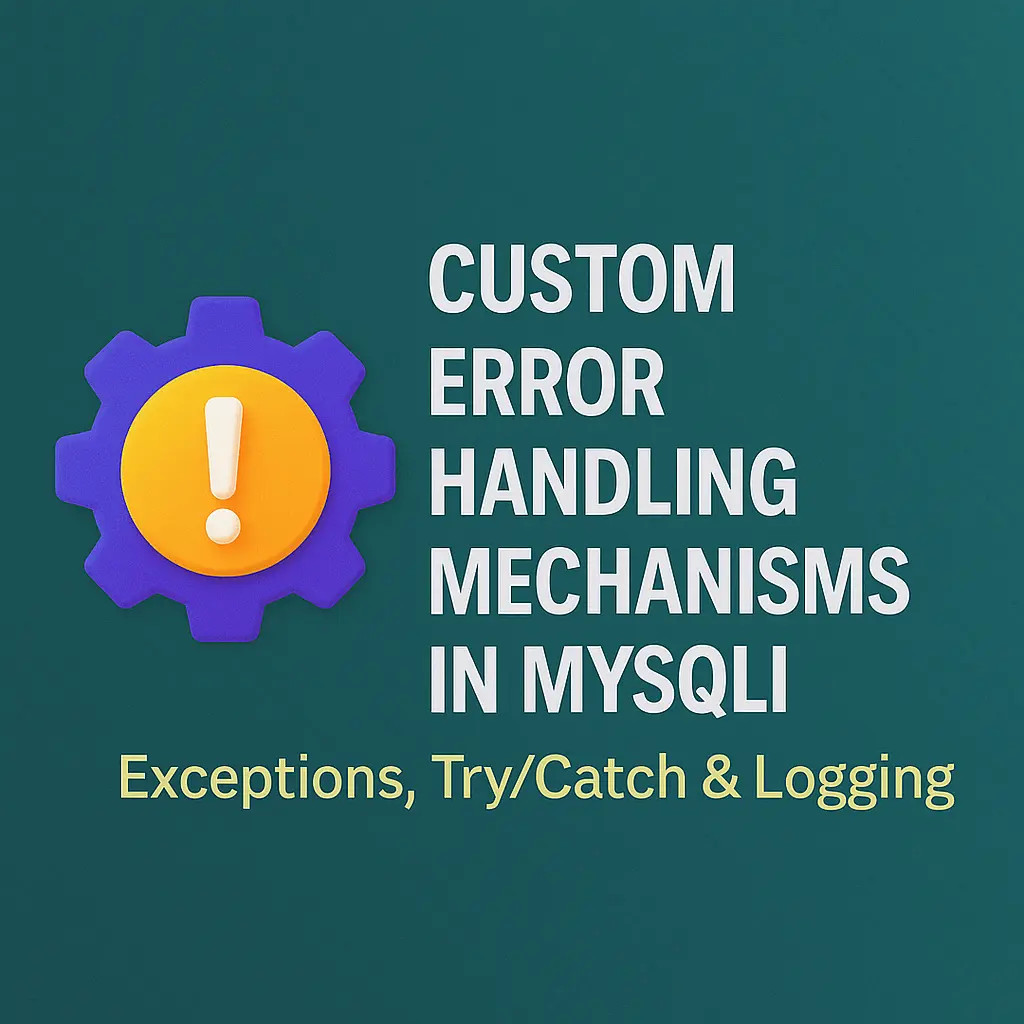This article explores creating custom error handling mechanisms in MySQLi, focusing on how to implement them to improve your application’s reliability and user experience.
Understanding MySQLi and Error Handling
MySQLi is an extension of PHP that provides an interface for interacting with MySQL databases. It offers both procedural and object-oriented methods, allowing developers to choose the style that best fits their needs. Error handling in MySQLi involves detecting and managing errors that occur during database operations, such as connection issues, query failures, or unexpected results.
Why Custom Error Handling?
While MySQLi provides basic error reporting through its built-in methods, custom error handling allows developers to:
- Provide More Context: Custom error handling can offer detailed and user-friendly error messages, improving the debugging process and user experience.
- Implement Logging: Custom mechanisms enable logging errors to files or databases, facilitating better tracking and analysis of issues.
- Graceful Degradation: Handle errors in a way that ensures the application continues to function, even if certain features encounter issues.
- Separation of Concerns: Keep error handling logic separate from the main application logic, making the codebase cleaner and more maintainable.
Creating Custom Error Handlers
Let’s explore how to create custom error handlers in MySQLi by following these steps:
- Setting Up a Basic MySQLi Connection
- Implementing a Custom Error Handler Function
- Handling Errors with Custom Logic
- Logging Errors
- Testing Error Handling
1. Setting Up a Basic MySQLi Connection
First, we need to establish a connection to a MySQL database using MySQLi. Here’s a basic example:
<?php
// Database configuration
$host = 'localhost';
$user = 'root';
$password = '';
$database = 'test_db';
// Create a connection
$conn = new mysqli($host, $user, $password, $database);
// Check the connection
if ($conn->connect_error) {
die("Connection failed: " . $conn->connect_error);
}
echo "Connected successfully";
?>
This code creates a connection to the MySQL database and checks for connection errors. If there is a connection issue, it stops execution and displays an error message.
2. Implementing a Custom Error Handler Function
To create a custom error handler, define a function that processes errors and then set it as the error handler for MySQLi operations. Here’s an example:
<?php
// Custom error handler function
function customErrorHandler($errno, $errstr, $errfile, $errline) {
$errorMessage = "Error: [$errno] $errstr - $errfile:$errline";
// Log the error
error_log($errorMessage, 3, 'errors.log');
// Display a user-friendly message
echo "Oops! Something went wrong. Please try again later.";
// Optionally, stop script execution
die();
}
// Set custom error handler
set_error_handler("customErrorHandler");
// Database configuration
$host = 'localhost';
$user = 'root';
$password = '';
$database = 'test_db';
// Create a connection
$conn = new mysqli($host, $user, $password, $database);
// Check the connection
if ($conn->connect_error) {
trigger_error("Connection failed: " . $conn->connect_error, E_USER_ERROR);
}
// Your SQL queries and logic here
?>
3. Handling Errors with Custom Logic
Custom error handling can be tailored to specific needs, such as handling different types of errors differently or performing additional actions. For example:
<?php
// Custom error handler function
function customErrorHandler($errno, $errstr, $errfile, $errline) {
$errorMessage = "Error: [$errno] $errstr - $errfile:$errline";
// Differentiate error types
switch ($errno) {
case E_USER_ERROR:
// Critical error, log and stop execution
error_log($errorMessage, 3, 'errors.log');
echo "A critical error occurred. Please contact support.";
die();
case E_USER_WARNING:
// Warning, log but continue execution
error_log($errorMessage, 3, 'errors.log');
echo "Warning: Please check the log for details.";
break;
case E_USER_NOTICE:
// Notice, log and continue execution
error_log($errorMessage, 3, 'errors.log');
echo "Notice: Check the log for more information.";
break;
default:
// Other errors
error_log($errorMessage, 3, 'errors.log');
echo "An unexpected error occurred.";
break;
}
}
// Set custom error handler
set_error_handler("customErrorHandler");
// Database configuration
$host = 'localhost';
$user = 'root';
$password = '';
$database = 'test_db';
// Create a connection
$conn = new mysqli($host, $user, $password, $database);
// Check the connection
if ($conn->connect_error) {
trigger_error("Connection failed: " . $conn->connect_error, E_USER_ERROR);
}
// Example query with potential error
$sql = "SELECT * FROM non_existing_table";
$result = $conn->query($sql);
if (!$result) {
trigger_error("Query failed: " . $conn->error, E_USER_WARNING);
}
// Continue with your logic...
?>
This example demonstrates how to handle different types of errors with custom logic, providing specific responses based on the severity of the error.
4. Logging Errors
Logging errors is an essential part of custom error handling, as it allows developers to review and analyze issues after they occur. You can customize the logging behavior to fit your needs. For instance, you might want to log errors to a database or an external monitoring service. Here’s how to log errors to a file:
<?php
function customErrorHandler($errno, $errstr, $errfile, $errline) {
$errorMessage = "[" . date('Y-m-d H:i:s') . "] Error: [$errno] $errstr - $errfile:$errline\n";
// Log the error to a file
file_put_contents('errors.log', $errorMessage, FILE_APPEND);
// Display a user-friendly message
echo "Oops! Something went wrong. Please try again later.";
// Optionally, stop script execution
die();
}
set_error_handler("customErrorHandler");
// Your database connection and query code here...
?>
In this code, file_put_contents is used to append error messages to errors.log, including a timestamp for better traceability.
5. Testing Error Handling
Testing custom error handling is crucial to ensure that it behaves as expected. You can simulate errors by:
- Creating Invalid Queries: Use incorrect SQL queries to trigger query-related errors.
- Forcing Connection Failures: Provide incorrect database credentials to test connection error handling.
- Testing Different Error Types: Use trigger_error with different error types (E_USER_ERROR, E_USER_WARNING, E_USER_NOTICE) to verify the handling logic.
Here’s a simple test script to check if custom error handling works as expected:
<?php
// Include the custom error handler script
// Test invalid query
$sql = "SELECT * FROM non_existing_table";
$result = $conn->query($sql);
// Test invalid connection
$invalid_conn = new mysqli('invalid_host', 'invalid_user', 'invalid_password', 'test_db');
if ($invalid_conn->connect_error) {
trigger_error("Connection failed: " . $invalid_conn->connect_error, E_USER_ERROR);
}
// Test user warning
trigger_error("This is a user warning test", E_USER_WARNING);
// Test user notice
trigger_error("This is a user notice test", E_USER_NOTICE);
?>






